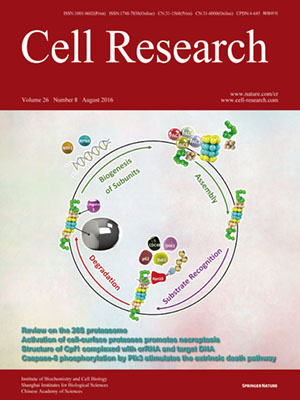
Volume 26, No 8, Aug 2016
ISSN: 1001-0602
EISSN: 1748-7838 2018
impact factor 17.848*
(Clarivate Analytics, 2019)
Volume 26 Issue 8, August 2016: 946-962
ORIGINAL ARTICLES
A high-resolution transcriptome map of cell cycle reveals novel connections between periodic genes and cancer
Daniel Dominguez1,2, Yi-Hsuan Tsai1,3, Nicholas Gomez2,4, Deepak Kumar Jha5, Ian Davis2,6,7,8 and Zefeng Wang1,2,9
1Department of Pharmacology, University of North Carolina at Chapel Hill, Chapel Hill, NC, USA
2Lineberger Comprehensive Cancer Center, University of North Carolina at Chapel Hill, Chapel Hill, NC, USA
3Program in Bioinformatics and Computational Biology, University of North Carolina at Chapel Hill, Chapel Hill, NC, USA
4Curriculum in Genetics and Molecular Biology, University of North Carolina at Chapel Hill, Chapel Hill, NC, USA
5Department of Biochemistry and Biophysics, University of North Carolina at Chapel Hill, Chapel Hill, NC, USA
6Department of Genetics, University of North Carolina at Chapel Hill, Chapel Hill, NC, USA
7Department of Pediatrics, University of North Carolina at Chapel Hill, Chapel Hill, NC, USA
8Carolina Center for Genome Sciences, University of North Carolina at Chapel Hill, Chapel Hill, NC, USA
9Key Lab of Computational Biology, CAS-MPG Partner Institute for Computational Biology, Chinese Academy of Science, Shanghai, China
Correspondence: Zefeng Wang,(wangzefeng@picb.ac.cn)
Progression through the cell cycle is largely dependent on waves of periodic gene expression, and the regulatory networks for these transcriptome dynamics have emerged as critical points of vulnerability in various aspects of tumor biology. Through RNA-sequencing of human cells during two continuous cell cycles (>2.3 billion paired reads), we identified over 1 000 mRNAs, non-coding RNAs and pseudogenes with periodic expression. Periodic transcripts are enriched in functions related to DNA metabolism, mitosis, and DNA damage response, indicating these genes likely represent putative cell cycle regulators. Using our set of periodic genes, we developed a new approach termed “mitotic trait” that can classify primary tumors and normal tissues by their transcriptome similarity to different cell cycle stages. By analyzing >4 000 tumor samples in The Cancer Genome Atlas (TCGA) and other expression data sets, we found that mitotic trait significantly correlates with genetic alterations, tumor subtype and, notably, patient survival. We further defined a core set of 67 genes with robust periodic expression in multiple cell types. Proteins encoded by these genes function as major hubs of protein-protein interaction and are mostly required for cell cycle progression. The core genes also have unique chromatin features including increased levels of CTCF/RAD21 binding and H3K36me3. Loss of these features in uterine and kidney cancers is associated with altered expression of the core 67 genes. Our study suggests new chromatin-associated mechanisms for periodic gene regulation and offers a predictor of cancer patient outcomes.
10.1038/cr.2016.84
FULL TEXT | PDF
Browse 1954


